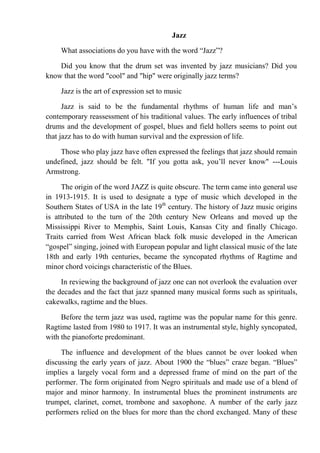
Jazz
- 1. Jazz<br />What associations do you have with the word “Jazz”?<br />Did you know that the drum set was invented by jazz musicians? Did you know that the word quot; coolquot; and quot; hipquot; were originally jazz terms? <br />Jazz is the art of expression set to music<br />Jazz is said to be the fundamental rhythms of human life and man’s contemporary reassessment of his traditional values. The early influences of tribal drums and the development of gospel, blues and field hollers seems to point out that jazz has to do with human survival and the expression of life.<br />Those who play jazz have often expressed the feelings that jazz should remain undefined, jazz should be felt. quot; If you gotta ask, you’ll never knowquot; ---Louis Armstrong. <br />The origin of the word JAZZ is quite obscure. The term came into general use in 1913-1915. It is used to designate a type of music which developed in the Southern States of USA in the late 19th century. The history of Jazz music origins is attributed to the turn of the 20th century New Orleans and moved up the Mississippi River to Memphis, Saint Louis, Kansas City and finally Chicago. Traits carried from West African black folk music developed in the American “gospel” singing, joined with European popular and light classical music of the late 18th and early 19th centuries, became the syncopated rhythms of Ragtime and minor chord voicings characteristic of the Blues.<br />In reviewing the background of jazz one can not overlook the evaluation over the decades and the fact that jazz spanned many musical forms such as spirituals, cakewalks, ragtime and the blues. <br />Before the term jazz was used, ragtime was the popular name for this genre. Ragtime lasted from 1980 to 1917. It was an instrumental style, highly syncopated, with the pianoforte predominant. <br />The influence and development of the blues cannot be over looked when discussing the early years of jazz. About 1900 the “blues” craze began. “Blues” implies a largely vocal form and a depressed frame of mind on the part of the performer. The form originated from Negro spirituals and made use of a blend of major and minor harmony. In instrumental blues the prominent instruments are trumpet, clarinet, cornet, trombone and saxophone. A number of the early jazz performers relied on the blues for more than the chord exchanged. Many of these jazz musicians used the blues for the driving force of their musical emotions. A leading figure of the blues era was the black composer W.C. Handy whose Memphis Blues and St Louis Blues are Jazz classics. <br />The subsequent history of jazz has embraced a diversity of styles: Dixieland, Symphonic jazz, swing, be-bop, free jazz, etc. <br />Dixieland, originated in 1912 borrowed elements from both ragtime and blues and made a feature of group improvisation led by the trumpet. The principal Dixieland musicians included the trumpeters King Oliver, Louis Armstrong, the pianists Jelly Roll Morton and Earl Hines. In 1920 jazz became more sophisticated as it spread to NY, Paris and London and became a social “rage”. The jazz arranger emerged and with him the bigger band: harmony became more conventional. Melodies were played by a full instrumental section. These “big bands” had marked individual styles. Paul Whiteman popularized “symphonic jazz” using violins ad elaborate arrangements. He, playing jazz-influenced dance music, was billed as the King of Jazz. At the other extreme was the Negro style of Duke Ellington, the first great jazz composer. A “Chicago” style revived smaller bands and more improvisation.<br />The 1930s coincided with the style known as “swing”. The swing bands led by virtuoso instrumentalists concentrated on precision, arrangement, and good ensemble work. Swing yielded in the 1940s to “be-bop”. Rhythm was the prime feature of be-bop, allied to scat singing. Tempi were fast and great virtuosity needed. “Be-bop” was later re-christened “modern jazz”.<br />The influence of jazz on so-called “serious” music had been widespread and beneficial. Charles Ives composed ragtime pieces for theatre orchestra as early as 1902, Ravel used the blues in his violin sonata, and both his pianoforte concertos are jazz-influenced; Stravinsky also wrote ragtime musical pieces. Among those who wrote works throwing a bridge between jazz and symphonic forms include Gershwin who was acclaimed to have made a respectable art form out of jazz, Leonard Bernstein, Leibermann, etc. <br />Those feelings as expression of blues music fits very comfortably with the strains and phrases of jazz. An ability to play the blues has been a requisite of all jazz musicians, who on first meeting one another or when taking part in a jam session, will often use the blues framework for improving. Blues, stemming from rural areas of the deep South, has a history largely independent of jazz. Exponents of blues usually accompanied themselves on guitar, piano or harmonica or were supported by small groups who often played unconventional or homemade instruments. <br />Jazz and Blues are among America's greatest cultural achievements and exports to the world community giving powerful voice to the American experience. Born of a multi-hued society, it unites people across the divides of race, region and national boundaries and has always made powerful statements about freedom, creativity and American identity at home and abroad.<br />Jazz is not the result of choosing a tune, but an ideal that is created first in the mind, inspired by one's passion, and willed next in playing music. Its unique expression draws from life experience and human emotion as the inspiration of the creative force, and through this discourse is chronicled the history of a people. Musicians and those that follow the genre closely, can indeed be thought of as an artistic community complete with its leaders, spokesmen, innovators, aficionados, members, bands, supporters & fans.<br />
